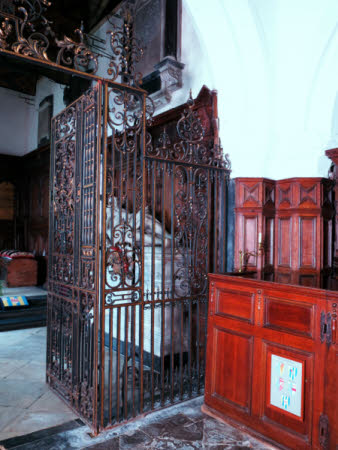Gatescreen
attributed to Robert Bakewell (1682 - 1752)
Category
Metalwork
Date
1700 - 1750
Materials
Wrought iron
Measurements
3000 x 1340 mm
Order this imageCollection
Staunton Harold Church, Leicestershire
NT 426913.4
Caption
These gilded, wrought iron gates and screen are located at the entrance to the sanctuary in the Holy Trinity Chapel in Staunton Harold in Leicestershire. They were made by Robert Bakewell, a local craftsman, who also created the gates and screen at Derby Cathedral and the birdcage garden structure at Melbourne Hall, Derbyshire. Holy Trinity Chapel was the family chapel of the Earl Ferrers. It was given to the National Trust in 1954 by the Earl Ferrers and is unique in being the only church built in England during the 1650s, when Oliver Cromwell was the Lord Protector and the monarchy had been deposed.
Summary
A wrought iron gilded screen forming part of the gates and screen by Robert Bakewell (1682-1752) in the Chapel of the Holy Trinity at Staunton Harold. This 18th Century screen is attached to the right hand wall of the Sanctuary and it separates the Nave from the Sanctuary and the gate is intricately detailed.
Provenance
The Chapel at Staunton Harold was presented to the National Trust by the 12th Earl Ferrers in 1954. A partial endowment was given by the Dulverton Trust, and the building was restored by public subsciption and with a munificent grant from the PilgrimTrust and grants from the Historic Churches Preservation Trust and the Incorporated Church Building Society.
Makers and roles
attributed to Robert Bakewell (1682 - 1752), maker
